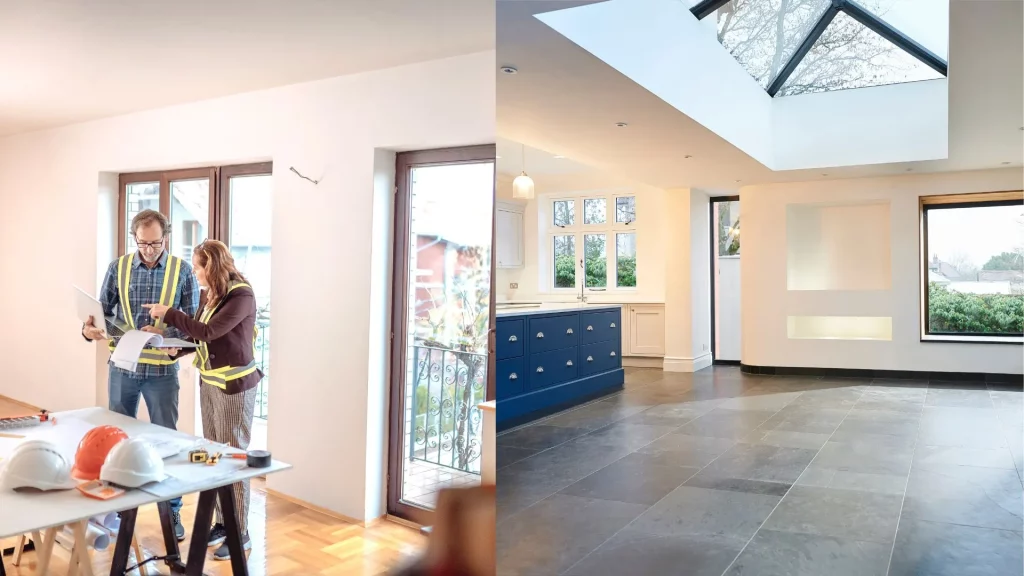Why Consider a House Extension or Renovation
A well-planned house extension or renovation can increase your property’s value while improving living conditions. Extensions utilize unused space and enhance functionality and aesthetics, making them a smart investment.
House extensions offer more living space and improve home comfort and functionality. They provide room for a growing family or a home office and boost property value without the hassle of moving.
Modernising Older Homes Without Losing Character
Modernising older homes while preserving their character involves a careful balance of updating features and maintaining historical elements. Here are some strategies to achieve this:
Preserve Original Features
- Mouldings and Trim: Keep or restore original mouldings, trim, and woodwork. These details add historical charm.
- Fireplaces: Maintain original fireplaces and mantels. If they are non-functional, consider converting them to gas or electric while keeping the original facade.
- Windows and Doors: Restore original windows and doors where possible. If replacements are necessary, choose designs that match the original style.
Blend Modern and Traditional Design
- Kitchen and Bathrooms: Update kitchens and bathrooms with modern amenities while using materials and fixtures that complement the home’s original style.
- Lighting: Use contemporary lighting fixtures that blend well with traditional elements. Consider vintage-style fixtures with modern efficiency.
- Furniture and Decor: Mix modern furniture with antique or vintage pieces to create a cohesive look that respects the home’s history.
Use Appropriate Materials
- Sustainable Materials: Opt for eco-friendly materials that match the original construction, such as reclaimed wood or recycled tiles.
- Matching Finishes: When adding new elements, use finishes that match or complement the existing materials, such as similar wood stains or paint colours.
Respect the Architectural Style
- Exterior Updates: When making exterior changes, respect the original architectural style. Use period-appropriate materials and designs for any additions or extensions.
- Roofline and Facade: Maintain the original roofline and facade details. If adding an extension, ensure it blends seamlessly with the existing structure.
Consult Professionals
- Architects and Designers: Work with architects and designers who specialize in historic homes. They can provide guidance on how to modernize while preserving character.
- Contractors: Choose contractors experienced in working with older homes to ensure that updates are done sensitively and correctly.
Common Types of Extensions
To build up or out – Deciding whether to extend or build up depends on your land size, home layout, and local council requirements. Consult with neighbours, local councils, and experts to make an informed decision.
Adding a bedroom with an ensuite is a common house extension. Many older homes traditionally have 3 bedrooms and 1 bathroom; adding a fourth bedroom with an ensuite is a great way to add space for modern living.
Lounge extensions are also popular, especially for older New Zealand homes based on English plans that orientate living areas for the northern hemisphere. Adding a new living area and reconfiguring existing spaces can be a great way to modernise these homes.
Planning a House Extension: Everything You Need to Know
- Understanding Your Needs and Budget: Define the purpose of the extension and set a realistic budget. Research costs, include a contingency fund, and ensure the extension meets your needs without financial stress.
- Choosing the Right Architect: Select an architect who understands your vision and offers professional advice on design and build aspects. Review their expertise and make an informed decision to ensure a seamless extension.
- Choosing the Right Builder: Select a builder who specialises in extensions and renovations. Working on older homes requires a different skill set. The right builder can provide more accurate costing with fewer unforeseen expenses and a more efficient project.
- Applying for Consent: Secure necessary consents before starting construction. Understand local council requirements, prepare a detailed application, and await approval to ensure compliance and avoid legal issues.
Improving Energy Efficiency and Heating in Older Homes
- Upgrade Insulation: Enhance wall, roof, and floor insulation to reduce heat loss. Consider using eco-friendly materials like recycled wool or cellulose.
- Install Energy-Efficient Windows: Replace single-pane windows with double-glazed options to improve thermal performance. Options for timber, aluminium, or PVC can be explored to get the right look at the right cost.
- Seal Gaps and Cracks: Use weatherstripping and caulking to seal gaps around doors, windows, and other openings to prevent drafts.
- Upgrade Heating Systems: Replace old fireplaces with modern, energy-efficient models. Heat pumps and central heating systems can be easily fitted to most older homes.
- Improve Ventilation: Ensure proper ventilation to maintain indoor air quality while minimizing energy loss. Consider heat recovery ventilation systems.
Conclusion
Modernising older homes without losing their character is a rewarding endeavour that combines the best of both worlds: contemporary comfort and historical charm. By preserving original features, blending modern and traditional design elements, using appropriate materials, and respecting the architectural style, you can create a home that honours its past while embracing the future.
Additionally, discreetly improving energy efficiency ensures that your home is not only beautiful but also sustainable. Renovation is also not limited to extensions and structural changes. Homeowners can integrate fresh decor, furniture and home accessories to reinforce their overall renovation project.
With careful planning and the right professional guidance, you can transform your older home into a modern masterpiece that retains its unique character and timeless appeal.


